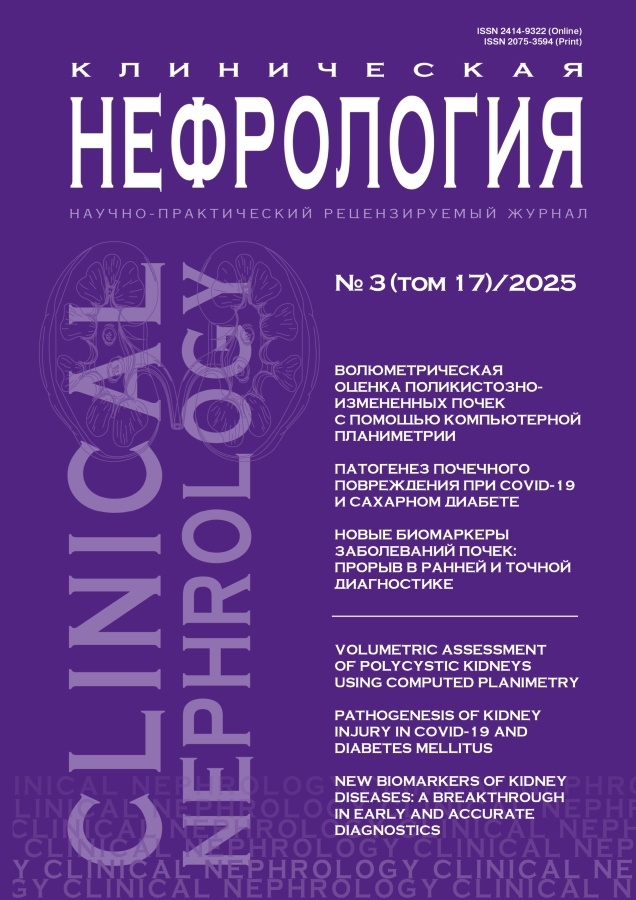Adiponectin as an important link in the pathogenesis of protein-energy malnutrition in patients receiving treatment with programmed hemodialysis: yes or no?
- Autores: Yakovenko A.A.1, Lavrishcheva Y.V.2
-
Afiliações:
- Pavlov First St. Petersburg State Medical University
- Almazov National Medical Research Center
- Edição: Volume 17, Nº 3 (2025)
- Páginas: 6-12
- Seção: Original Articles
- URL: https://journals.eco-vector.com/2075-3594/article/view/692600
- DOI: https://doi.org/10.18565/nephrology.2025.3.6-12
- ID: 692600
Citar
Texto integral
Resumo
Objective. Evaluation of the relationship between the blood serum adiponectin level and protein-energy malnutrition (PEM) indices in patients receiving programmed hemodialysis (HD).
Material and methods. A total of 645 patients receiving programmed HD treatment were examined, including 300 men and 345 women aged 56.8±12.8 years. All patients received programmed HD treatment for 8.4±5.3 years. Nutritional status was assessed to diagnose PEM using the method proposed by ISRNM (International Society of Renal Nutrition and Metabolism). Serum adiponectin levels were determined by a method based on a three-stage "sandwich" version of solid-phase enzyme-linked immunosorbent assay using mono- and polyclonal antibodies to adiponectin using the commercial Adiponectin ELISA kit (Mediagnost, Germany), in accordance with the manufacturer's instructions. Reference values for adiponectin were: for women: 3.58–9.66 ng/ml, for men: 2–5.6 ng/ml.
Results. The mean values of adiponectin levels in patients without signs of PEM were 8.4±3.0 ng/ml, and in patients with PEM – 12.1±2.6 ng/ml (p<0.0001). The results of nonparametric correlation analysis revealed negative statistically significant relationships between the serum adiponectin level and the level of the main indicators of nutritional status: total serum protein (Rs = - 0.472; p < 0.0001), serum albumin (Rs = - 0.764; p < 0.0001), serum prealbumin (Rs = - 0.428, p < 0.0001), serum transferrin (Rs = - 0.577; p < 0.0001), blood lymphocytes (Rs = - 0.518; p < 0.0001), arm muscle circumference - AMC (Rs = - 0.618; p < 0.0001), skeletal muscle mass index, according to bioimpedance analysis (Rs = - 0.636; p < 0.0001)) and positive statistically significant relationships between the serum adiponectin level and the percentage of body fat according to bioimpedancemetry (Rs=0.152; p<0.0001).
Conclusion. The obtained data convincingly demonstrated a close relationship between elevated serum adiponectin levels and PEM in patients receiving treatment with programmed HD.
Palavras-chave
Texto integral
Sobre autores
Aleksandr Yakovenko
Pavlov First St. Petersburg State Medical University
Autor responsável pela correspondência
Email: leptin-rulit@mail.ru
ORCID ID: 0000-0003-1045-9336
Cand.Sci. (Med.), Associate Professor at the Department of Nephrology and Dialysis
Rússia, St. PetersburgYulia Lavrishcheva
Almazov National Medical Research Center
Email: lavrischeva@gmail.com
ORCID ID: 0000-0002-3073-2785
Cand.Sci. (Med.), Associate Professor at the Department of Faculty Therapy with the Clinic
Rússia, St. PetersburgBibliografia
- Cheng T.C., Huang S.H., Kao C.L., Hsu P.C. Muscle Wasting in Chronic Kidney Disease: Mechanism and Clinical Implications-A Narrative Review. Int. J. Mol. Sci. 2022;23(11):6047. Doi: 10.3390/ ijms23116047.
- Thurlow J.S., Joshi M., Yan G. et al. Global Epidemiology of End-Stage Kidney Disease and Disparities in Kidney Replacement Therapy. Am. J. Nephrol. 2021;52(2):98–107. doi: 10.1159/000514550.
- Carrero J.J., Thomas F., Nagy K. et al. Global Prevalence of Protein-Energy Wasting in Kidney Disease: A Meta-analysis of Contemporary Observational Studies From the International Society of Renal Nutrition and Metabolism. J. Renal Nutrition. 2018;28(6):380–92. Doi: 10.1053/ j.jrn.2018.08.006.
- Kang S.S., Chang J.W., Park Y. Nutritional Status Predicts 10-Year Mortality in Patients with End-Stage Renal Disease on Hemodialysis. Nutrients 2017;9(4):399. doi: 10.3390/nu9040399.
- Fouque D., Kalantar-Zadeh K., Kopple J. et al. A proposed nomenclature and diagnostic criteria for protein-energy wasting in acute and chronic kidney disease. Kidney Int. 2008;73(4):391–8. doi: 10.1038/sj.ki.5002585.
- Obi Y., Qader H., Kovesdy C.P., Kalantar-Zadeh K. Latest consensus and update on protein-energy wasting in chronic kidney disease. Curr. Opin. Clin. Nutr. Metab. Care. 2015;18(3):254–62. doi: 10.1097/MCO.0000000000000171.
- Gregg L.P., Carmody T., Le D., et al. A Systematic Review and Meta-Analysis of Depression and Protein-Energy Wasting in Kidney Disease. Kidney Int. Rep. 2020;5(3):318–30. doi: 10.1016/j.ekir.2019.12.009.
- Markaki А., Psylinakis E., Spyridaki A. Adiponectin and end-stage renal disease. Hormones (Athens) 2016;15(3):345–54. doi: 10.14310/horm.2002.1698.
- Harada H., Kai H., Shibata R. et al. New diagnostic index for sarcopenia in patients with cardiovascular diseases. PLoS One. 2017;12(5):e0178123. doi: 10.1371/journal.pone.0178123.
- Beberashvili I., Cohen-Cesla T., Khatib A. et al. Comorbidity burden may explain adiponectin’s paradox as a marker of increased mortality risk in hemodialysis patients. Sci. Rep. 2021;11(1):9087. doi: 10.1038/s41598-021-88558-0.
- Guebre-Egziabher F., Bernhard J., Funahashi T. et al. Adiponectin in chronic kidney disease is related more to metabolic disturbances than to decline in renal function. Nephrol. Dial. Transplant. 2005;20(1):129–34. doi: 10.1093/ndt/gfh568.
- Coope A., Milanski M., P Araújo E. et al. AdipoR1 mediates the anorexigenic and insulin/leptin-like actions of adiponectin in the hypothalamus. FEBS Lett. 2008;582(10):1471–6. doi: 10.1016/j.febslet.2008.03.037.
Arquivos suplementares








